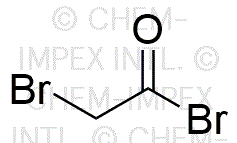Bromoacetyl bromide is widely utilized in research focused on:
- Synthesis of Pharmaceuticals: It serves as a key intermediate in the production of various pharmaceuticals, particularly in the synthesis of anti-cancer and anti-inflammatory agents.
- Organic Synthesis: This compound is employed in organic chemistry for the introduction of bromoacetyl groups into organic molecules, facilitating the development of new compounds with desired properties.
- Polymer Chemistry: Bromoacetyl bromide is used in the modification of polymers, enhancing their properties for applications in coatings, adhesives, and sealants.
- Research in Biochemistry: It plays a role in the study of enzyme inhibitors and protein modifications, aiding researchers in understanding biological processes and developing new therapeutic strategies.
- Material Science: The compound is utilized in the development of specialty materials, including those with unique thermal and mechanical properties, benefiting industries such as electronics and automotive.
General Information
Properties
Safety and Regulations
Applications
Bromoacetyl bromide is widely utilized in research focused on:
- Synthesis of Pharmaceuticals: It serves as a key intermediate in the production of various pharmaceuticals, particularly in the synthesis of anti-cancer and anti-inflammatory agents.
- Organic Synthesis: This compound is employed in organic chemistry for the introduction of bromoacetyl groups into organic molecules, facilitating the development of new compounds with desired properties.
- Polymer Chemistry: Bromoacetyl bromide is used in the modification of polymers, enhancing their properties for applications in coatings, adhesives, and sealants.
- Research in Biochemistry: It plays a role in the study of enzyme inhibitors and protein modifications, aiding researchers in understanding biological processes and developing new therapeutic strategies.
- Material Science: The compound is utilized in the development of specialty materials, including those with unique thermal and mechanical properties, benefiting industries such as electronics and automotive.
Documents
Safety Data Sheets (SDS)
The SDS provides comprehensive safety information on handling, storage, and disposal of the product.
Product Specification (PS)
The PS provides a comprehensive breakdown of the product’s properties, including chemical composition, physical state, purity, and storage requirements. It also details acceptable quality ranges and the product's intended applications.
Certificates of Analysis (COA)
Search for Certificates of Analysis (COA) by entering the products Lot Number. Lot and Batch Numbers can be found on a product’s label following the words ‘Lot’ or ‘Batch’.
*Catalog Number
*Lot Number
Certificates Of Origin (COO)
This COO confirms the country where the product was manufactured, and also details the materials and components used in it and whether it is derived from natural, synthetic, or other specific sources. This certificate may be required for customs, trade, and regulatory compliance.
*Catalog Number
*Lot Number
Safety Data Sheets (SDS)
The SDS provides comprehensive safety information on handling, storage, and disposal of the product.
DownloadProduct Specification (PS)
The PS provides a comprehensive breakdown of the product’s properties, including chemical composition, physical state, purity, and storage requirements. It also details acceptable quality ranges and the product's intended applications.
DownloadCertificates of Analysis (COA)
Search for Certificates of Analysis (COA) by entering the products Lot Number. Lot and Batch Numbers can be found on a product’s label following the words ‘Lot’ or ‘Batch’.
*Catalog Number
*Lot Number
Certificates Of Origin (COO)
This COO confirms the country where the product was manufactured, and also details the materials and components used in it and whether it is derived from natural, synthetic, or other specific sources. This certificate may be required for customs, trade, and regulatory compliance.


